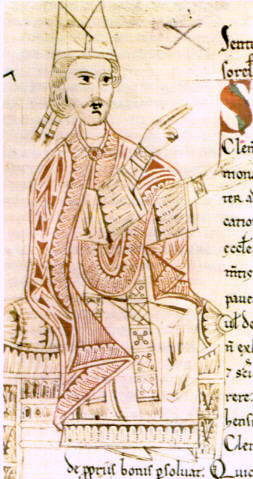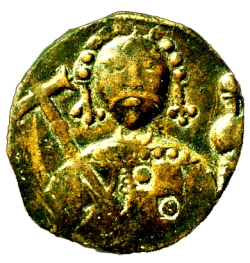 |
| Matilda of Canossa |
Conflicting Synods
Gregory held a Lenten Synod in 1075 where he
condemned all ecclesiastical investitures by laymen, infuriating the emperor who
immediately invested two German bishops and nominated a second Archbishop
of Milan. Gregory was a man who was unable to compromise, even when his
principles were not involved and he was unlikely to take Henry’s provocations
lying down.
Henry called the German bishops to a Synod at Worms on January 24th 1076.
He denounced Gregory as a false monk and formally deposed the pope as his
father had done three times before. German chroniclers, writing of the Worms synod in
January 1076, suggested that Godfrey the Hunchback inspired Henry's allegation
of a licentious affair between Pope Gregory and Matilda. The bishops wrote to Gregory from
Worms;
‘You have filled the entire
church, as it were, with the stench of the gravest of scandals, rising from
your intimacy and cohabitation with another’s wife who is more closely
integrated into your household than is necessary.’[i]
Acting on Henry’s suggestions the Synod deposed Gregory.
In 1074, on the eve of Gregory’s crusade, Matilda had been overcome by a spiritual crisis, brought on by the breakdown of her marriage. She contemplated renouncing her responsibilities and entering a convent. Whether it was pure strength of mind or whether she was given spiritual advice by Gregory is unknown as are the truth of the allegations of adultery[ii].]
Widowhood
On 26th February 1076 Godfrey the Hunchback was the victim of an assassination attack in Flanders while "answering the call of nature". He lingered for a week after the attack before dying. The adultery accusation coming so soon before Godfrey’s death meant that Matilda was suspected of ordering her estranged husband's death. It is unlikely that she was involved as the accusations of adultery could not have reached her in time to set up an assassination in Flanders[iii].
Less than two months later Matilda’s mother died as well, considerably augmenting Matilda’s power. She was now the undisputed heir of all her parents' allodial lands. Her inheritance would have been threatened had Godfrey survived her mother, but she now enjoyed the privileged status of a widow. Matilda spent much of her time trying to bridge the gulf between pope and emperor.
 |
| Agnes of Poitou (R) |
Gregory accepted the princes’ invitation and Matilda helped facilitate a meeting between the two at Trebur;
‘Meanwhile by the advice of the most holy Abbot of Cluny, and of the queen-mother Agnes, and also of the aforesaid most wise Matilda, a general council the
king and the apostle [Gregory] themselves was proclaimed, for the sake of peace
and justice.’[iv]
Matilda’s main role in the meeting was to ensure Gregory’s safe arrival. He was escorted by her troops as he travelled north to Mantua where he was to await the promised escort of German troops. The escort of German troops never arrived, leaving Gregory and Matilda poised in Mantua.
It Ends at Canossa
 |
| Hugh of Cluny (L), Henry IV (C), Matilda of Canossa (R) |
Henry decided to drive a wedge between the rebels in Germany and
Gregory; he decided to avoid a meeting in Germany. In the depths of winter
Henry and his wife Bertha of Savoy set out
across the mountain passes to head off the pope off. Upon hearing the news that
the emperor was in Italy Gregory diverted to Canossa.
‘He [Gregory] turned aside, at Matilda’s urging,
into….Canossa, intending to wait until he could more carefully discover the purpose
of his [Henry’s] arrival, namely, whether he came to beg forgiveness or to
avenge the injury of his excommunication by force of arms.’[v]
For his part when he heard that Gregory was now ensconced in Canossa, Henry headed there. In the gown of a penitent, barefoot and hair-shirted he was left outside the castle gates for three days (and nights) in the January ice and snow.
Gregory was finally persuaded by Matilda and Hugh of Cluny to allow the emperor to enter the castle on 28th January. Once inside the castle Henry made cause with Hugh and Matilda who persuaded Gregory to revoke the excommunication.
Matilda was a devout champion of the church and while her loyalty to Gregory was unswerving, Henry’s Walk to Canossa went some way to changing her mind about the emperor. She and Countess Adelaide of Turin were Henry’s sponsors, formally swearing to the agreement between pope and emperor. Gregory stayed as Matilda’s guest for seven months, staying within her defensible domain.
Henry’s cause was not helped by the pope’s reversal of the excommunication; his opponents chose a new emperor, Rudolf of Swabia, at the Diet of Augsburg in February 1077. They declared that in future the emperor must be elected. The empire itself was swallowed up by civil war.
Post Canossa
 |
| Godfrey of Bouillon |
The quarrel between aunt and nephew over the episcopal county of Verdun was eventually settled by Theoderic, Bishop of Verdun, who enjoyed the right to nominate the counts. He found in Matilda’s favour, knowing that such verdict would please both Pope Gregory and the Emperor. Matilda then proceeded to enfeoff Verdun to her stepfather’s sister’s grandson, Albert III of Namur[vi] who she supported in his battle to become Duke of Bouillon.
Throughout this period the antagonism between north and south continued at a lesser level. A number of prelates travelling between the two parties had been ambushed; immediately after the concord at Canossa Bishop Gerald of Ostia had been seized by Dionisio[vii], the Bishop of Piacenza. Matilda aided Gregory in getting Gerald freed. Another incident later in the year saw Abbot Bernhard of Marseilles imprisoned for six months by Ulrich, Count of Lenzburg.
Supporting the Rebels
 |
| Henry IV (L) and Antipope Clement III (C) |
In response on 25th June 1080 Henry IV summoned a council in Brixen, which deposed Gregory, electing Archbishop Wibert of Ravenna[viii] in his place. This followed an assembly at Mainz by prelates loyal to Henry who declared Gregory;
‘[An] execrable disturber of the laws of God and
man.’[ix]
Matilda and Gregory planned a pre-emptive strike at Wibert in Ravenna and committed their forces in the summer, scheduling the attack for the autumn[x]. Before the attack could be launched Henry’s supporters surprised Matilda; on 15th October 1080, near Volta Mantovana[xi], the imperial troops defeated Gregory’s loyal troops commanded by Matilda; it was her first serious defeat; Matilda’s troops were put to flight.
Rudolf of Swabia died on 15th October 1080 from wounds received during the battle on the Elster, this intercession was viewed as divine by Henry’s supporters. Hermann of Salm was elected in Rudolf’s place, but he had little support.
Bibliography
The Making
of Europe – Robert Bartlett, Penguin Books 1994
The Military
Leadership of Matilda of Canossa – David J Hay, Manchester University Press
2008
The Holy
Roman Empire – Friedrich Heer, Phoenix Giant Paperback 1995
The Oxford
History of Medieval Europe – George Holmes, Oxford University Press, 2001
Absolute
Monarchs – John Julius Norwich, Random House 2011
The First
Crusade – Steven Runciman, Folio Society 2002
The Hapsburgs
– Andrew Wheatcroft, Folio Society 2004
www.wikipedia.en
[i]
The Military Leadership of Matilda of Canossa - Hay
[ii]
Although the allegations might be considered unlikely in a pope crusading
within the church for chastity among the clergy
[iii]
The allegations would have to allow for a double winter crossing of the Alps
which would be barely passable at this time of year
[iv]
The Military Leadership of Matilda of Canossa - Hay
[v]
Ibid
[vi]
The deep animosity between Matilda and
Godfrey may have prevented her from travelling to Jerusalem during the First Crusade, which was led by Godfrey in the late 1090s
[vii]
Deposed by Gregory
[viii]
Antipope Clement III
[ix]
The Military Leadership of Matilda of Canossa - Hay
[x]
Robert Guiscard was scheduled to join in the attack, long with Jordan of Capua,
having made up his differences with the pope in June at Ceprano. Neither man sent the
promised troop, Guiscard being diverted by his quarrels with Byzantium. Jordan
defected to support Henry in 1082
[xi]
In Mantua province; Matilda’s castle was close to the Veronese entrance to the Brenner Pass, normally
used by the Emperors on their visits to their Italian lands




